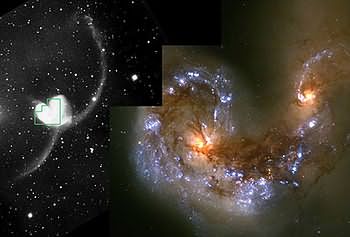|
|
 The Antennae (NGC 4038/4039) are a pair of colliding galaxies in the constellation Corvus (a southern hemisphere constellation, which is why you don't recognise the name). The ground-based view (left) shows the long "tidal tails" of stars ejected from the collision; the HST close-up (right) shows new star formation (blue stars) initiated by the collision. These galaxies started out as normal spirals; when the merged galaxy produced by the collision finally settles down, it will probably look like an elliptical galaxy. (From the HST archive.)
The Antennae (NGC 4038/4039) are a pair of colliding galaxies in the constellation Corvus (a southern hemisphere constellation, which is why you don't recognise the name). The ground-based view (left) shows the long "tidal tails" of stars ejected from the collision; the HST close-up (right) shows new star formation (blue stars) initiated by the collision. These galaxies started out as normal spirals; when the merged galaxy produced by the collision finally settles down, it will probably look like an elliptical galaxy. (From the HST archive.)
|
Summary of Lecture 9 – Galaxy Evolution
- Galaxies could form (like stars) from the collapse of a gas cloud under gravity:
- globular clusters form on elliptical orbits as the gas falls
towards the centre;
- if the cloud has some net rotation (always the case in practice!),
frictional energy loss in the gas will cause it to settle into a disc
around a central bulge:
- stars formed after this happens are already in circular orbits:
disc stars;
- stars formed before this do not settle into disc:
halo stars;
- dark matter also unlikely to settle into disc, because it
is very weakly interacting, so essentially frictionless;
- this model seems a plausible explanation for spiral galaxies
- Elliptical galaxies may form as a consequence of
collisions and mergers:
- they are more common in dense environments where collisions would be more common;
- their stars orbit in a less ordered fashion (result of disruption?);
- they sometimes show faint "shells" of higher star numbers (relics of
shock waves from interactions?);
- they have little remaining gas (used up or ejected from galaxy?)
- Colliding or otherwise interacting galaxies are observed:
- collisions initiate bursts of new star formation;
- stars and gas are lost in "tidal tails";
- more common at high redshift (i.e. a long time ago);
- well reproduced by computer simulations.
- Spiral structure in spiral galaxies needs explanation:
- if they were simply accidental concentrations of stars, they would
"wind up" in a few orbits;
- presence of new stars suggests density wave of
higher density gas (cf. sound wave):
- increase in gas density triggers star formation;
- presence of more mass attracts nearby stars, affecting their
orbits
- such a wave could be generated by bar (for barred spirals), satellite
galaxy or near-collision (all of which are seen).
- We can test theories of galaxy evolution by studying very distant galaxies:
- light takes a long time to reach us → see cluster as it was a
long time ago;
- pictures of very distant galaxies (e.g. Hubble Deep Fields) show
- higher proportion of interacting galaxies;
- greater proportion of irregular or disrupted galaxies –
fewer "normal" spirals;
- large population of small, faint blue galaxies (which may later
collide and merge to form modern galaxies);
- Some distant galaxies show high levels of activity
emanating from their central nuclei:
- such active galactic nuclei (AGN) are much more
common at great distances –
- this is a temporary stage in the life cycle of young galaxies;
- observations indicate very high luminosity and presence of fast-moving
hot gas:
- likely power source is accretion of gas by supermassive
black hole;
- activity would cease if gas in central region depleted (material
further out is in "safe" stable orbits: Sun in no danger of
being swallowed by Milky Way's black hole);
- evidence from nearby galaxies is that supermassive black holes are common (usual?) in centres of large galaxies: black hole mass larger for larger central bulge.
Web links
- The PowerPoint file for this lecture.
- Nick Strobel covers galaxy formation and active galaxies; Gene Smith doesn't cover galaxy evolution, but does discuss active galaxies and galaxy collisions.
- The animations of colliding galaxies came from Chris Mihos at Case Western, the NPACI newsletter (the online version of which appears to have vanished, sorry!) and an online article (also vanished) by John Dubinski.
- Bill Keel has an online slide set about active galaxies, rather technical, but with nice pictures! The atlas of radio galaxies page at Jodrell Bank has some introductory material about radio galaxies and cosmology, and a lot of pictures. As usual, the HST press archive also includes some spectacular pictures of active galaxies.
- There is an incredibly extensive "knowledge base" for extragalactic astronomy and cosmology at Caltech. The articles collected here are, however, generally very technical.
- A short self test for this lecture.
Go back to main page
Go on to Summary for Lecture 10
|
Hicks Building, Hounsfield Road, Sheffield S3 7RH, UK
|